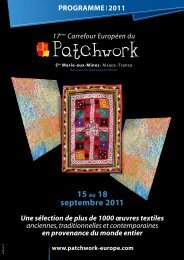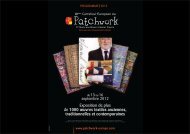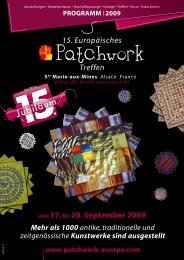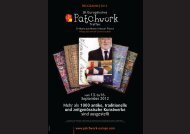Mehr als 1000 antike, traditionelle und ... - Patchwork Europe
Mehr als 1000 antike, traditionelle und ... - Patchwork Europe
Mehr als 1000 antike, traditionelle und ... - Patchwork Europe
Sie wollen auch ein ePaper? Erhöhen Sie die Reichweite Ihrer Titel.
YUMPU macht aus Druck-PDFs automatisch weboptimierte ePaper, die Google liebt.
Kurs Nr. 15 :<br />
Ghost layers and color washes<br />
Katie Pasquini (United States)<br />
Contemporary – Art quilt<br />
Price: 75 € • 6h – F, E<br />
All levels – machine<br />
Ghost layers and color washes are about layers<br />
of transparency. We will work with an 18” (46cm) format<br />
creating a base layer consisting of 4 sections, the ghost layer consists<br />
of several shapes that float and then the paint layer is made with<br />
watercolor paint. All layers are then combined and colors worked out.<br />
Basic supplies: 3, 8, 9, 10, 13, 14, 19, 20<br />
Fabrics to bring: Fabrics in the colors you want to use, (3 different colors that match<br />
the 3 tubes of paint you have chosen for the water color layer) sorted into 7 different<br />
values of each. Make separate piles of each of the steps, step 1 being white and very<br />
pale shades of the color, step 2 being a little darker, on through all of the steps to step<br />
7 which will be black and very dark shades of the color. Have several pieces in each<br />
of the steps for each of the different colors you choose to work with. That would be<br />
a minimum of 3 in each step times 7 steps for at least 21 different pieces for each of<br />
the different colors times 3 different colors for at least 63 fabrics. The more fabrics<br />
you have to choose from the easier it will be. You will not need very much of any one<br />
color fat eights or thirds of a yard should be enough. Keep these in the separate steps<br />
by putting a paper spacer between them in a shoe box or transport them in zip lock<br />
bags. Sorting is the most time consuming, please bring them sorted and I will help<br />
fine tune the steps in class. If you like working with black and white prints bring them<br />
in the seven steps as well.<br />
Other supplies: invisible thread ; 2» (5cm) brush ; 3» (8cm) foam brush (art supply<br />
or hardware store) ; a small palate, (can be foam meat trays or white picnic plates),<br />
container for water ; 3 small tubes of water color paint from these colors (choose<br />
3) red, yellow, orange, blue, green and purple ; 3 colored pencils to match the colors<br />
you choose ; pencil for drawing ; pencils for marking on fabric ; compass ; rags and/or<br />
paper towels ; tape ; washcloth ; spray starch ; standard stapler that opens up flat and<br />
lots of extra staples ; 01 fine point pigma pen ;<br />
Following supplies in 50 cm large : 1 foam core board to use as a working board to<br />
staple their project to ; 1 poster board for template ; 4 sheets tracing paper ; 2 sheets<br />
watercolour paper.<br />
Kit (optional) : 2 €, includes 1 sulky stabilizer .<br />
> Kurs Nr. 16 :<br />
Ginga – Galaxy – effet 3D avec<br />
des textiles et du fil<br />
Chiaki Dosho (Japon)<br />
Contemporain – Art Quilt,<br />
applications directes<br />
Prix : 85 € • 6 h – F – tous niveaux – machine<br />
Les participants apprendront à utiliser le relief (3D) avec des tissus<br />
et des fils. Pour ce faire, ils coudront morceau par morceau un grand<br />
nombre de petits bouts de tissus qui par leur densité créeront un effet<br />
tridimensionnel. Avec cette technique, les résultats seront différents<br />
suivant la taille et la texture des morceaux et la façon dont ils seront<br />
cousus. Les fils constitueront l’autre aspect important de cette<br />
technique. Selon la couleur, la texture et les longueurs des fils, laissés<br />
pendre, l’effet obtenu sera différent. Le professeur aura des kits de<br />
vieux kimonos japonais en soie à la disposition des participants.<br />
Fournitures de base : 4, 7, 8, 13, 21<br />
Tissus : 90x50cm de molleton thermocollant ; 90x50cm de tissu pour le dos ; 30x40cm<br />
de 4 à 5 sortes de tissus blancs ; 30x40cm de 3 à 4 sortes de tissus de couleur ; toute<br />
sorte de tissus (soies, cotons, laines, fibres synthétiques). Les tissus devront être fins,<br />
souples, unis ou proches de l’uni (ton sur ton).<br />
Autres fournitures : Un assortiment de fils polyester, de rayonne pour la broderie<br />
machine (4 à 5 sortes), du fil pour la cannette.<br />
Kit (optionnel) : 48 € contenant des tissus de vieux kimonos japonais en soie.<br />
> Kurs Nr. 17 :<br />
Effets 3D, plier, twister, coudre<br />
Yoko Okamoto (Japon)<br />
Contemporain – appliqué, piécé<br />
Prix : 85 € • 6h – F – tous niveaux - main<br />
Créer des motifs par la méthode du pliage, ajouter un<br />
effet tridimensionnel à vos quilts appliqués ou piécés ! Le matin,<br />
les participants réaliseront différents échantillons pliés à incorporer<br />
dans un quilt. L’après-midi, ils feront un joli sac composé d’hexagones<br />
tridimensionnels.<br />
Fournitures de base : 1, 3, 4, 7, 8, 9, 11, 12, 13, 14, 15, 21, 22, 23<br />
Tissus : 50x 50cm de 3 à 4 tissus différents.<br />
Kit (optionnel) : 10 € contenant des tissus de style japonais.<br />
> Kurs Nr. 18 :<br />
Technique de la piqûre de Marseille pour<br />
boutis contemporains et traditionnels<br />
Hubert Valeri (France)<br />
Contemporain / Traditionnel –<br />
Boutis / Travail à la main<br />
Prix : 75 € • 6h – F – tous niveaux - (idem cours n°11)<br />
L’apprentissage des points de Vauvert et des points d’Aix<br />
conduisent à découvrir le « savoir-faire » pour le sertissage du dessin<br />
(couture des deux tissus) puis pour le méchage (mise en relief ), les<br />
deux phases de la technique de la piqûre de Marseille pour réaliser<br />
un boutis ; le cours permet d’acquérir les bases pour continuer à<br />
« boutisser » sans difficulté.<br />
Fournitures de base : 1, 2 (n°10), 3 (couleur), 5 (blanc 100 % coton), 6, 7<br />
Autres fournitures nécessaires : (1) trousse à aiguilles personnelles ; (6) dés à<br />
quilter : pour droitier (inverser pour gaucher) 1 pour le majeur de la main droite<br />
et 1 pour l’index de la main gauche ; ciseaux à broder en bon état ; 1 tambour à<br />
broder Ø 12cm ; 1 tambour à broder Ø 18 ou 20cm ; coton à tricoter n°8 de chez<br />
Lebaufil.<br />
Kit (obligatoire): 15 € contenant tissu imprimé à l’encre lavable sur batiste de<br />
coton et batiste de dos : choix entre 4 dessins conçus pédagogiquement pour des<br />
ouvrages (losanges ≈ 13.5cm de côté) à incruster (chemin de table, rideaux…)<br />
> Kurs Nr. 19 :<br />
Fabric Painted Flowers<br />
Lenore Crawford (United States)<br />
Contemporary – Dye / paint<br />
Price: 75 € • 6h – F, E – all levels<br />
Learn to paint your own realistic flowers<br />
using fabric paints like Lenore. She will<br />
guide you through this process starting from a photo<br />
of a flower and painting it onto a piece of muslin. You will take<br />
home your own painted flower art quilt ready to add to your art quilt.<br />
Lenore is inspired from her own photos she takes in gardens and on<br />
her travels aro<strong>und</strong> the world.<br />
Basic supplies: 12, 13, 21.<br />
Fabrics to bring: White muslin or plain white fabric at 45 cm X 60 cm or smaller if<br />
desired.<br />
Other supplies: lPhoto of a flower printed out at about 45 cm X 60 cm ; Lenore will<br />
bring some photos that can be used <strong>als</strong>o; Paint brushes: ½ angular, 10 angular or flat,<br />
¼ angular, 1/8 angular, 10/0 flat ; thin permanent marker ; painter’s tape.<br />
Kit *: 20 €, includes Muslin white 200 ct. about 45 cm X 60 cm ; Fabric paints Lenore<br />
uses: Setacolor Pebeo opaque when possible of lemon yellow, cherry red, fuchsia,<br />
turquoise, titanium white, black laque, cornflower blue, red ochre, and orange ; Clear<br />
plastic about 45 cm X 60 cm ; White plate and cup for water ; Paper towels.<br />
p.15<br />
Die Kurse









